Research Methodology Report: Solar Energy System Evaluation
VerifiedAdded on 2023/03/23
|11
|2288
|58
Report
AI Summary
This report details the research methodology for a study on solar energy, addressing the research question of the concept behind solar energy. It employs a mixed research design, combining qualitative analysis of existing literature with quantitative data gathered through surveys distributed to 40 users of Solar City Corporation within the United States. The study examines variables such as solar energy's impact and the influence of government regulations. Data collection involves primary data from questionnaires and secondary data from literature reviews. Statistical analysis using Microsoft Excel is employed to interpret the collected data. The report includes a questionnaire appendix and a cover letter for survey participants. The methodology aims to improve the quality and validity of the research and obtain comprehensive information about solar energy and its advantages over traditional energy systems. The report aims to achieve the aims and objectives of the research in an effective manner, reducing issues during the research process and providing a way to achieve the aims and objectives of the research in an effective manner.

SOLAR ENERGY 0
Solar energy
Solar energy
Paraphrase This Document
Need a fresh take? Get an instant paraphrase of this document with our AI Paraphraser
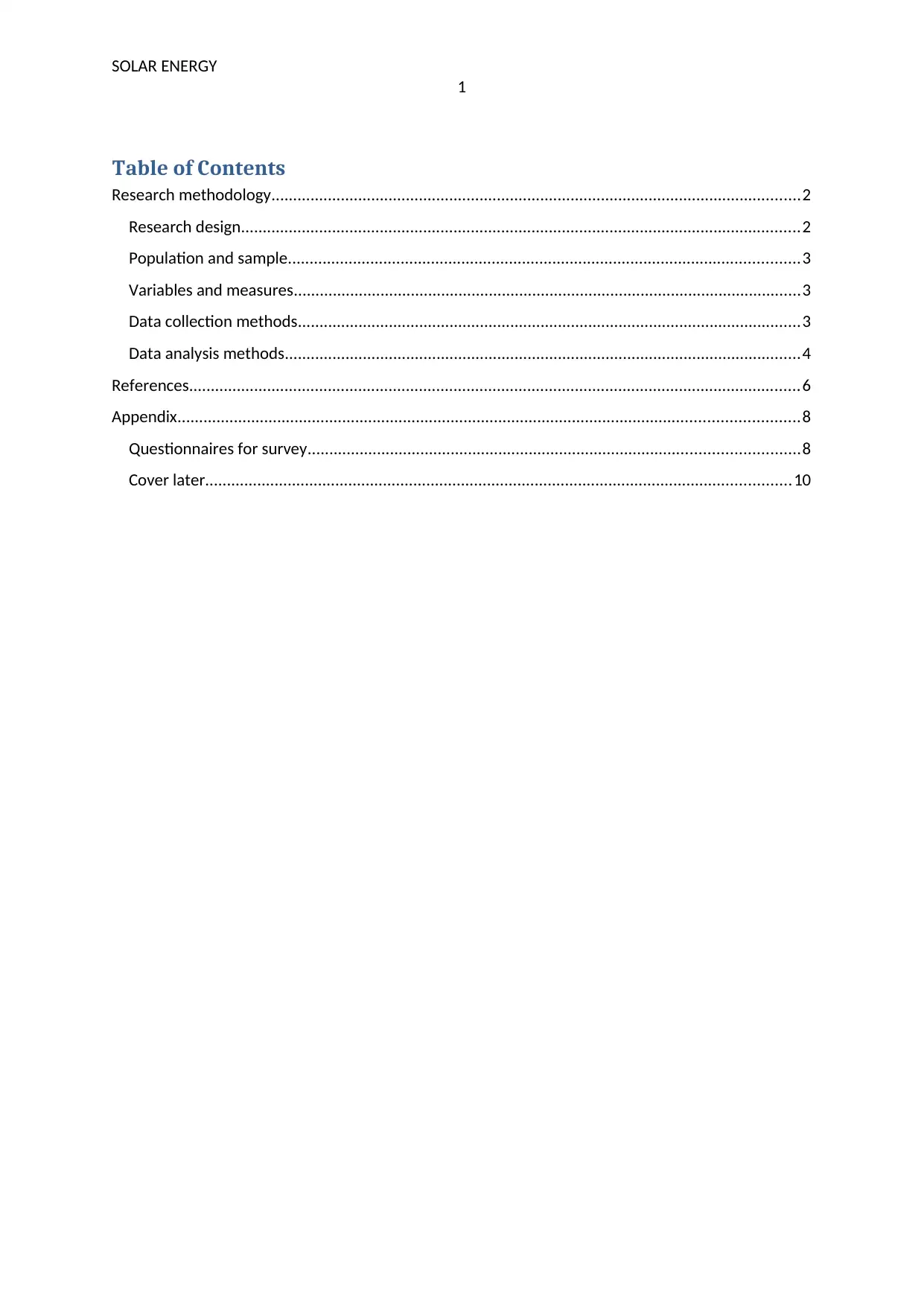
SOLAR ENERGY
1
Table of Contents
Research methodology..........................................................................................................................2
Research design.................................................................................................................................2
Population and sample......................................................................................................................3
Variables and measures.....................................................................................................................3
Data collection methods....................................................................................................................3
Data analysis methods.......................................................................................................................4
References.............................................................................................................................................6
Appendix...............................................................................................................................................8
Questionnaires for survey.................................................................................................................8
Cover later.......................................................................................................................................10
1
Table of Contents
Research methodology..........................................................................................................................2
Research design.................................................................................................................................2
Population and sample......................................................................................................................3
Variables and measures.....................................................................................................................3
Data collection methods....................................................................................................................3
Data analysis methods.......................................................................................................................4
References.............................................................................................................................................6
Appendix...............................................................................................................................................8
Questionnaires for survey.................................................................................................................8
Cover later.......................................................................................................................................10
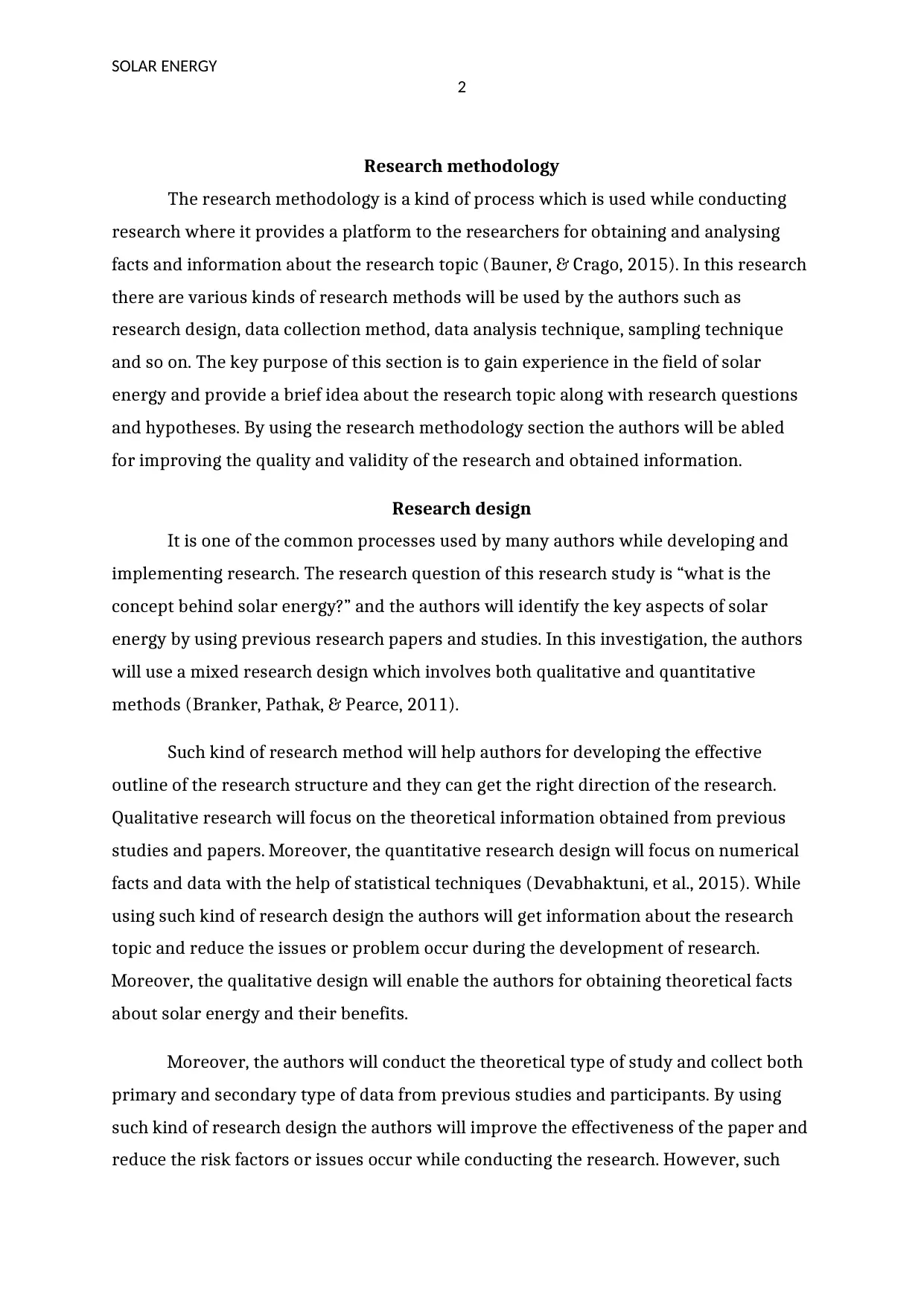
SOLAR ENERGY
2
Research methodology
The research methodology is a kind of process which is used while conducting
research where it provides a platform to the researchers for obtaining and analysing
facts and information about the research topic (Bauner, & Crago, 2015). In this research
there are various kinds of research methods will be used by the authors such as
research design, data collection method, data analysis technique, sampling technique
and so on. The key purpose of this section is to gain experience in the field of solar
energy and provide a brief idea about the research topic along with research questions
and hypotheses. By using the research methodology section the authors will be abled
for improving the quality and validity of the research and obtained information.
Research design
It is one of the common processes used by many authors while developing and
implementing research. The research question of this research study is “what is the
concept behind solar energy?” and the authors will identify the key aspects of solar
energy by using previous research papers and studies. In this investigation, the authors
will use a mixed research design which involves both qualitative and quantitative
methods (Branker, Pathak, & Pearce, 2011).
Such kind of research method will help authors for developing the effective
outline of the research structure and they can get the right direction of the research.
Qualitative research will focus on the theoretical information obtained from previous
studies and papers. Moreover, the quantitative research design will focus on numerical
facts and data with the help of statistical techniques (Devabhaktuni, et al., 2015). While
using such kind of research design the authors will get information about the research
topic and reduce the issues or problem occur during the development of research.
Moreover, the qualitative design will enable the authors for obtaining theoretical facts
about solar energy and their benefits.
Moreover, the authors will conduct the theoretical type of study and collect both
primary and secondary type of data from previous studies and participants. By using
such kind of research design the authors will improve the effectiveness of the paper and
reduce the risk factors or issues occur while conducting the research. However, such
2
Research methodology
The research methodology is a kind of process which is used while conducting
research where it provides a platform to the researchers for obtaining and analysing
facts and information about the research topic (Bauner, & Crago, 2015). In this research
there are various kinds of research methods will be used by the authors such as
research design, data collection method, data analysis technique, sampling technique
and so on. The key purpose of this section is to gain experience in the field of solar
energy and provide a brief idea about the research topic along with research questions
and hypotheses. By using the research methodology section the authors will be abled
for improving the quality and validity of the research and obtained information.
Research design
It is one of the common processes used by many authors while developing and
implementing research. The research question of this research study is “what is the
concept behind solar energy?” and the authors will identify the key aspects of solar
energy by using previous research papers and studies. In this investigation, the authors
will use a mixed research design which involves both qualitative and quantitative
methods (Branker, Pathak, & Pearce, 2011).
Such kind of research method will help authors for developing the effective
outline of the research structure and they can get the right direction of the research.
Qualitative research will focus on the theoretical information obtained from previous
studies and papers. Moreover, the quantitative research design will focus on numerical
facts and data with the help of statistical techniques (Devabhaktuni, et al., 2015). While
using such kind of research design the authors will get information about the research
topic and reduce the issues or problem occur during the development of research.
Moreover, the qualitative design will enable the authors for obtaining theoretical facts
about solar energy and their benefits.
Moreover, the authors will conduct the theoretical type of study and collect both
primary and secondary type of data from previous studies and participants. By using
such kind of research design the authors will improve the effectiveness of the paper and
reduce the risk factors or issues occur while conducting the research. However, such
⊘ This is a preview!⊘
Do you want full access?
Subscribe today to unlock all pages.

Trusted by 1+ million students worldwide
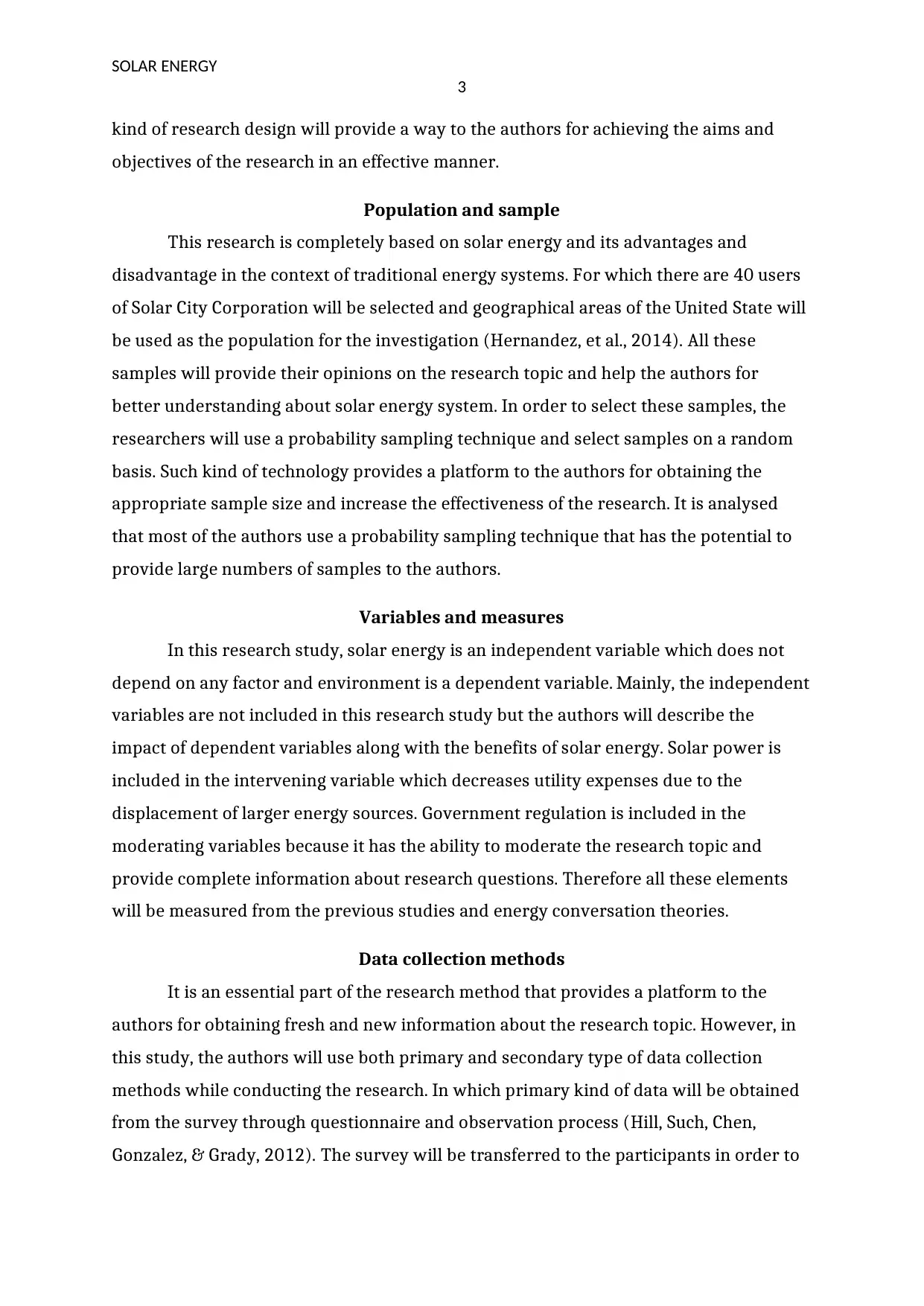
SOLAR ENERGY
3
kind of research design will provide a way to the authors for achieving the aims and
objectives of the research in an effective manner.
Population and sample
This research is completely based on solar energy and its advantages and
disadvantage in the context of traditional energy systems. For which there are 40 users
of Solar City Corporation will be selected and geographical areas of the United State will
be used as the population for the investigation (Hernandez, et al., 2014). All these
samples will provide their opinions on the research topic and help the authors for
better understanding about solar energy system. In order to select these samples, the
researchers will use a probability sampling technique and select samples on a random
basis. Such kind of technology provides a platform to the authors for obtaining the
appropriate sample size and increase the effectiveness of the research. It is analysed
that most of the authors use a probability sampling technique that has the potential to
provide large numbers of samples to the authors.
Variables and measures
In this research study, solar energy is an independent variable which does not
depend on any factor and environment is a dependent variable. Mainly, the independent
variables are not included in this research study but the authors will describe the
impact of dependent variables along with the benefits of solar energy. Solar power is
included in the intervening variable which decreases utility expenses due to the
displacement of larger energy sources. Government regulation is included in the
moderating variables because it has the ability to moderate the research topic and
provide complete information about research questions. Therefore all these elements
will be measured from the previous studies and energy conversation theories.
Data collection methods
It is an essential part of the research method that provides a platform to the
authors for obtaining fresh and new information about the research topic. However, in
this study, the authors will use both primary and secondary type of data collection
methods while conducting the research. In which primary kind of data will be obtained
from the survey through questionnaire and observation process (Hill, Such, Chen,
Gonzalez, & Grady, 2012). The survey will be transferred to the participants in order to
3
kind of research design will provide a way to the authors for achieving the aims and
objectives of the research in an effective manner.
Population and sample
This research is completely based on solar energy and its advantages and
disadvantage in the context of traditional energy systems. For which there are 40 users
of Solar City Corporation will be selected and geographical areas of the United State will
be used as the population for the investigation (Hernandez, et al., 2014). All these
samples will provide their opinions on the research topic and help the authors for
better understanding about solar energy system. In order to select these samples, the
researchers will use a probability sampling technique and select samples on a random
basis. Such kind of technology provides a platform to the authors for obtaining the
appropriate sample size and increase the effectiveness of the research. It is analysed
that most of the authors use a probability sampling technique that has the potential to
provide large numbers of samples to the authors.
Variables and measures
In this research study, solar energy is an independent variable which does not
depend on any factor and environment is a dependent variable. Mainly, the independent
variables are not included in this research study but the authors will describe the
impact of dependent variables along with the benefits of solar energy. Solar power is
included in the intervening variable which decreases utility expenses due to the
displacement of larger energy sources. Government regulation is included in the
moderating variables because it has the ability to moderate the research topic and
provide complete information about research questions. Therefore all these elements
will be measured from the previous studies and energy conversation theories.
Data collection methods
It is an essential part of the research method that provides a platform to the
authors for obtaining fresh and new information about the research topic. However, in
this study, the authors will use both primary and secondary type of data collection
methods while conducting the research. In which primary kind of data will be obtained
from the survey through questionnaire and observation process (Hill, Such, Chen,
Gonzalez, & Grady, 2012). The survey will be transferred to the participants in order to
Paraphrase This Document
Need a fresh take? Get an instant paraphrase of this document with our AI Paraphraser
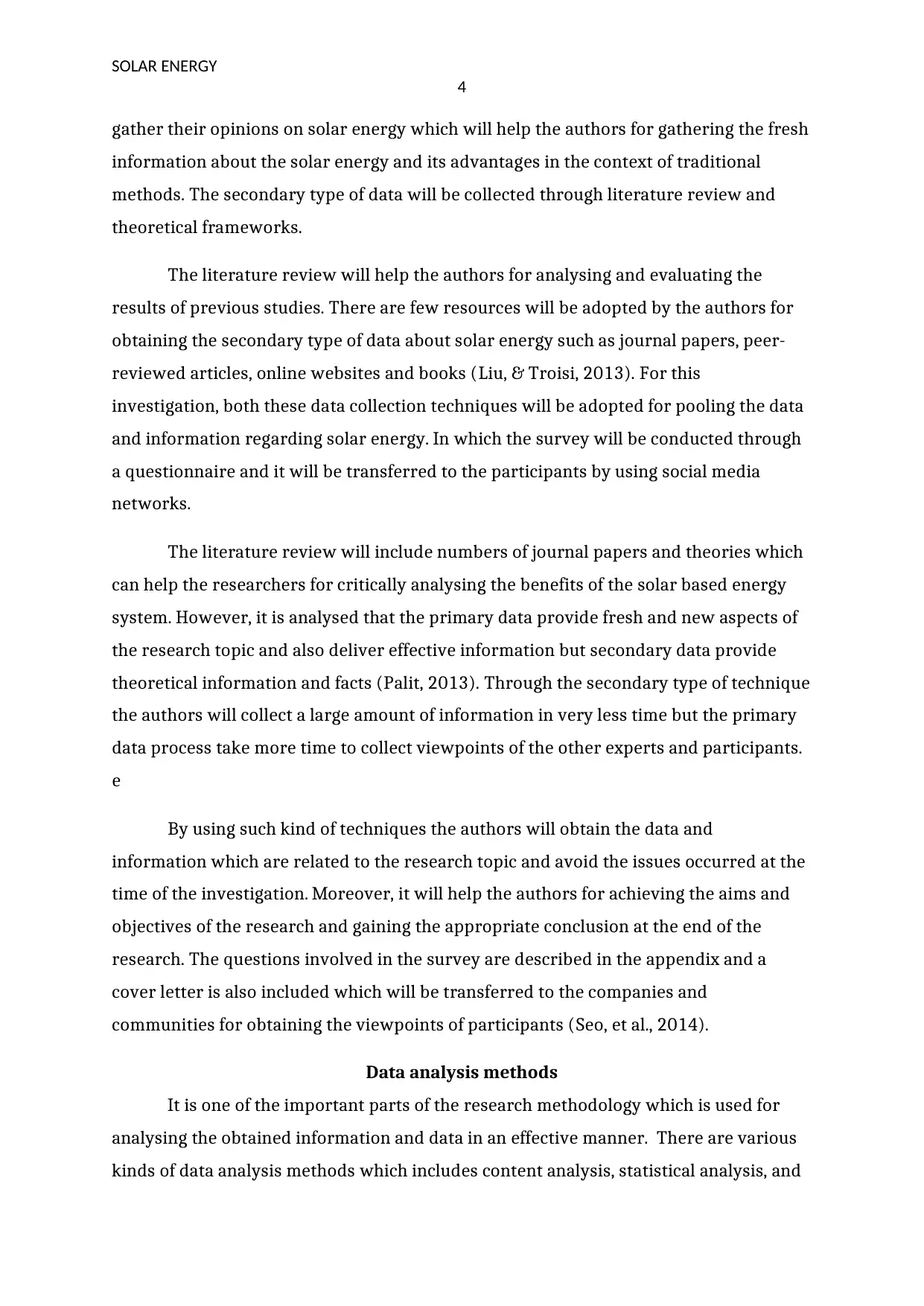
SOLAR ENERGY
4
gather their opinions on solar energy which will help the authors for gathering the fresh
information about the solar energy and its advantages in the context of traditional
methods. The secondary type of data will be collected through literature review and
theoretical frameworks.
The literature review will help the authors for analysing and evaluating the
results of previous studies. There are few resources will be adopted by the authors for
obtaining the secondary type of data about solar energy such as journal papers, peer-
reviewed articles, online websites and books (Liu, & Troisi, 2013). For this
investigation, both these data collection techniques will be adopted for pooling the data
and information regarding solar energy. In which the survey will be conducted through
a questionnaire and it will be transferred to the participants by using social media
networks.
The literature review will include numbers of journal papers and theories which
can help the researchers for critically analysing the benefits of the solar based energy
system. However, it is analysed that the primary data provide fresh and new aspects of
the research topic and also deliver effective information but secondary data provide
theoretical information and facts (Palit, 2013). Through the secondary type of technique
the authors will collect a large amount of information in very less time but the primary
data process take more time to collect viewpoints of the other experts and participants.
e
By using such kind of techniques the authors will obtain the data and
information which are related to the research topic and avoid the issues occurred at the
time of the investigation. Moreover, it will help the authors for achieving the aims and
objectives of the research and gaining the appropriate conclusion at the end of the
research. The questions involved in the survey are described in the appendix and a
cover letter is also included which will be transferred to the companies and
communities for obtaining the viewpoints of participants (Seo, et al., 2014).
Data analysis methods
It is one of the important parts of the research methodology which is used for
analysing the obtained information and data in an effective manner. There are various
kinds of data analysis methods which includes content analysis, statistical analysis, and
4
gather their opinions on solar energy which will help the authors for gathering the fresh
information about the solar energy and its advantages in the context of traditional
methods. The secondary type of data will be collected through literature review and
theoretical frameworks.
The literature review will help the authors for analysing and evaluating the
results of previous studies. There are few resources will be adopted by the authors for
obtaining the secondary type of data about solar energy such as journal papers, peer-
reviewed articles, online websites and books (Liu, & Troisi, 2013). For this
investigation, both these data collection techniques will be adopted for pooling the data
and information regarding solar energy. In which the survey will be conducted through
a questionnaire and it will be transferred to the participants by using social media
networks.
The literature review will include numbers of journal papers and theories which
can help the researchers for critically analysing the benefits of the solar based energy
system. However, it is analysed that the primary data provide fresh and new aspects of
the research topic and also deliver effective information but secondary data provide
theoretical information and facts (Palit, 2013). Through the secondary type of technique
the authors will collect a large amount of information in very less time but the primary
data process take more time to collect viewpoints of the other experts and participants.
e
By using such kind of techniques the authors will obtain the data and
information which are related to the research topic and avoid the issues occurred at the
time of the investigation. Moreover, it will help the authors for achieving the aims and
objectives of the research and gaining the appropriate conclusion at the end of the
research. The questions involved in the survey are described in the appendix and a
cover letter is also included which will be transferred to the companies and
communities for obtaining the viewpoints of participants (Seo, et al., 2014).
Data analysis methods
It is one of the important parts of the research methodology which is used for
analysing the obtained information and data in an effective manner. There are various
kinds of data analysis methods which includes content analysis, statistical analysis, and
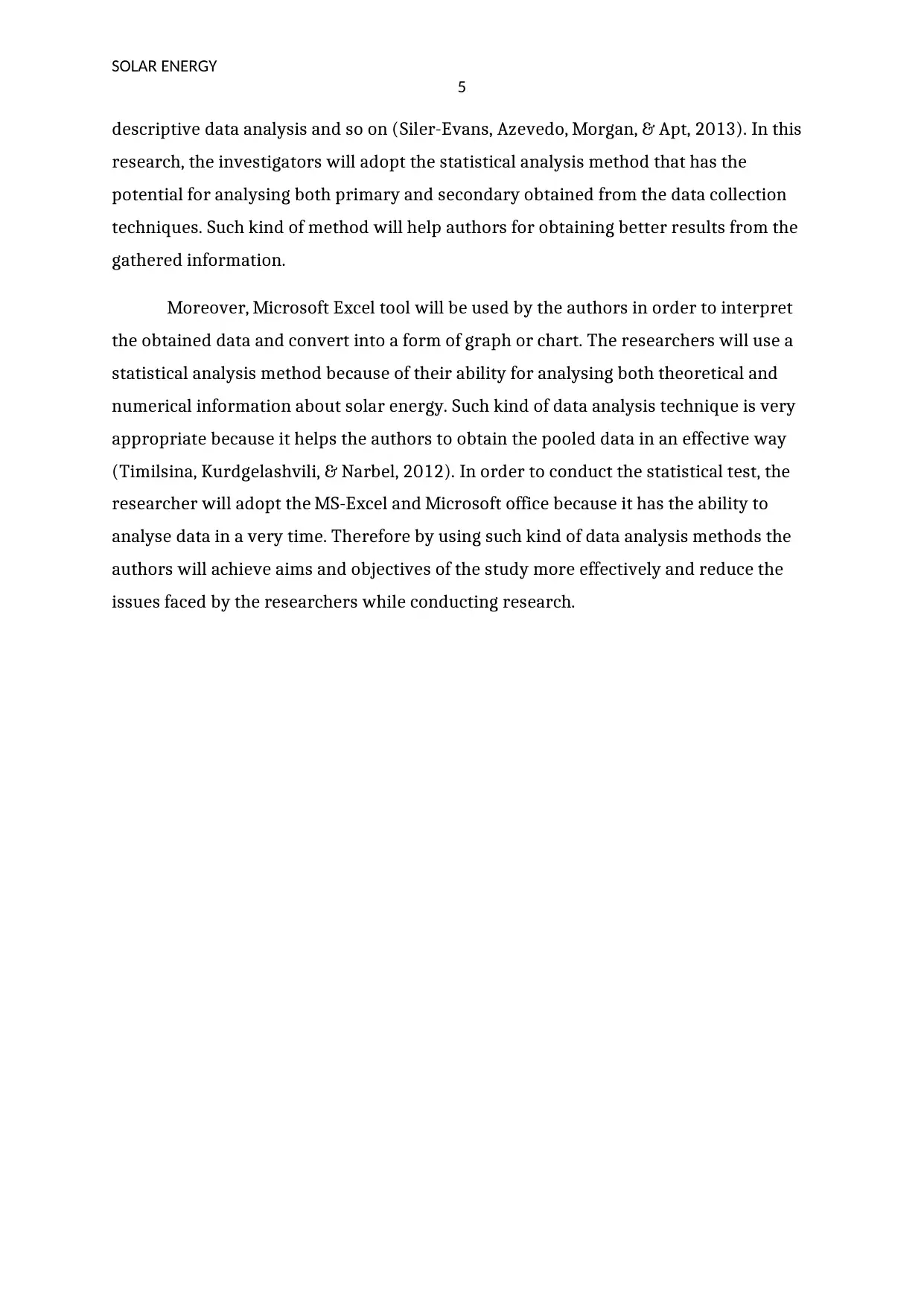
SOLAR ENERGY
5
descriptive data analysis and so on (Siler-Evans, Azevedo, Morgan, & Apt, 2013). In this
research, the investigators will adopt the statistical analysis method that has the
potential for analysing both primary and secondary obtained from the data collection
techniques. Such kind of method will help authors for obtaining better results from the
gathered information.
Moreover, Microsoft Excel tool will be used by the authors in order to interpret
the obtained data and convert into a form of graph or chart. The researchers will use a
statistical analysis method because of their ability for analysing both theoretical and
numerical information about solar energy. Such kind of data analysis technique is very
appropriate because it helps the authors to obtain the pooled data in an effective way
(Timilsina, Kurdgelashvili, & Narbel, 2012). In order to conduct the statistical test, the
researcher will adopt the MS-Excel and Microsoft office because it has the ability to
analyse data in a very time. Therefore by using such kind of data analysis methods the
authors will achieve aims and objectives of the study more effectively and reduce the
issues faced by the researchers while conducting research.
5
descriptive data analysis and so on (Siler-Evans, Azevedo, Morgan, & Apt, 2013). In this
research, the investigators will adopt the statistical analysis method that has the
potential for analysing both primary and secondary obtained from the data collection
techniques. Such kind of method will help authors for obtaining better results from the
gathered information.
Moreover, Microsoft Excel tool will be used by the authors in order to interpret
the obtained data and convert into a form of graph or chart. The researchers will use a
statistical analysis method because of their ability for analysing both theoretical and
numerical information about solar energy. Such kind of data analysis technique is very
appropriate because it helps the authors to obtain the pooled data in an effective way
(Timilsina, Kurdgelashvili, & Narbel, 2012). In order to conduct the statistical test, the
researcher will adopt the MS-Excel and Microsoft office because it has the ability to
analyse data in a very time. Therefore by using such kind of data analysis methods the
authors will achieve aims and objectives of the study more effectively and reduce the
issues faced by the researchers while conducting research.
⊘ This is a preview!⊘
Do you want full access?
Subscribe today to unlock all pages.

Trusted by 1+ million students worldwide
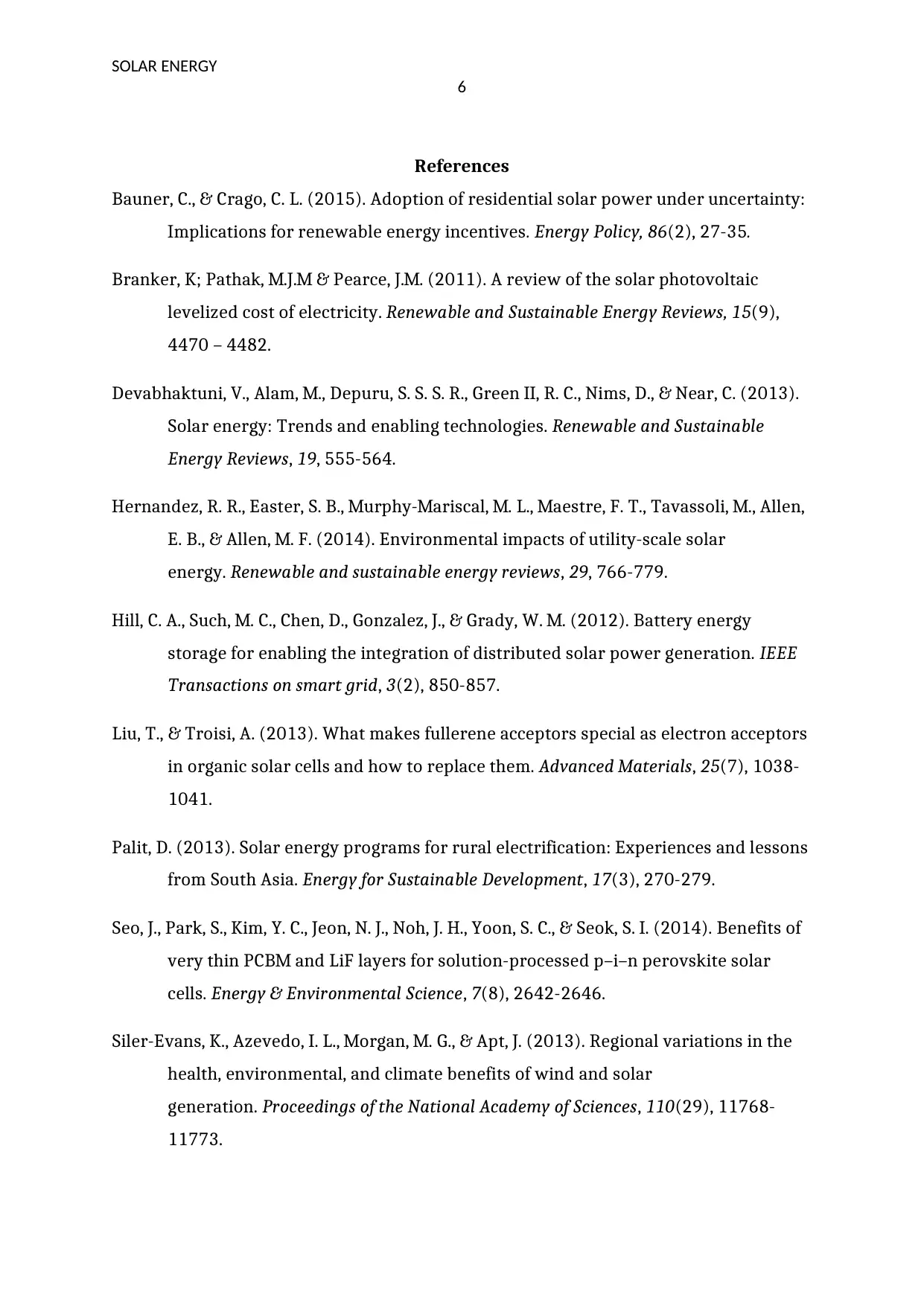
SOLAR ENERGY
6
References
Bauner, C., & Crago, C. L. (2015). Adoption of residential solar power under uncertainty:
Implications for renewable energy incentives. Energy Policy, 86(2), 27-35.
Branker, K; Pathak, M.J.M & Pearce, J.M. (2011). A review of the solar photovoltaic
levelized cost of electricity. Renewable and Sustainable Energy Reviews, 15(9),
4470 – 4482.
Devabhaktuni, V., Alam, M., Depuru, S. S. S. R., Green II, R. C., Nims, D., & Near, C. (2013).
Solar energy: Trends and enabling technologies. Renewable and Sustainable
Energy Reviews, 19, 555-564.
Hernandez, R. R., Easter, S. B., Murphy-Mariscal, M. L., Maestre, F. T., Tavassoli, M., Allen,
E. B., & Allen, M. F. (2014). Environmental impacts of utility-scale solar
energy. Renewable and sustainable energy reviews, 29, 766-779.
Hill, C. A., Such, M. C., Chen, D., Gonzalez, J., & Grady, W. M. (2012). Battery energy
storage for enabling the integration of distributed solar power generation. IEEE
Transactions on smart grid, 3(2), 850-857.
Liu, T., & Troisi, A. (2013). What makes fullerene acceptors special as electron acceptors
in organic solar cells and how to replace them. Advanced Materials, 25(7), 1038-
1041.
Palit, D. (2013). Solar energy programs for rural electrification: Experiences and lessons
from South Asia. Energy for Sustainable Development, 17(3), 270-279.
Seo, J., Park, S., Kim, Y. C., Jeon, N. J., Noh, J. H., Yoon, S. C., & Seok, S. I. (2014). Benefits of
very thin PCBM and LiF layers for solution-processed p–i–n perovskite solar
cells. Energy & Environmental Science, 7(8), 2642-2646.
Siler-Evans, K., Azevedo, I. L., Morgan, M. G., & Apt, J. (2013). Regional variations in the
health, environmental, and climate benefits of wind and solar
generation. Proceedings of the National Academy of Sciences, 110(29), 11768-
11773.
6
References
Bauner, C., & Crago, C. L. (2015). Adoption of residential solar power under uncertainty:
Implications for renewable energy incentives. Energy Policy, 86(2), 27-35.
Branker, K; Pathak, M.J.M & Pearce, J.M. (2011). A review of the solar photovoltaic
levelized cost of electricity. Renewable and Sustainable Energy Reviews, 15(9),
4470 – 4482.
Devabhaktuni, V., Alam, M., Depuru, S. S. S. R., Green II, R. C., Nims, D., & Near, C. (2013).
Solar energy: Trends and enabling technologies. Renewable and Sustainable
Energy Reviews, 19, 555-564.
Hernandez, R. R., Easter, S. B., Murphy-Mariscal, M. L., Maestre, F. T., Tavassoli, M., Allen,
E. B., & Allen, M. F. (2014). Environmental impacts of utility-scale solar
energy. Renewable and sustainable energy reviews, 29, 766-779.
Hill, C. A., Such, M. C., Chen, D., Gonzalez, J., & Grady, W. M. (2012). Battery energy
storage for enabling the integration of distributed solar power generation. IEEE
Transactions on smart grid, 3(2), 850-857.
Liu, T., & Troisi, A. (2013). What makes fullerene acceptors special as electron acceptors
in organic solar cells and how to replace them. Advanced Materials, 25(7), 1038-
1041.
Palit, D. (2013). Solar energy programs for rural electrification: Experiences and lessons
from South Asia. Energy for Sustainable Development, 17(3), 270-279.
Seo, J., Park, S., Kim, Y. C., Jeon, N. J., Noh, J. H., Yoon, S. C., & Seok, S. I. (2014). Benefits of
very thin PCBM and LiF layers for solution-processed p–i–n perovskite solar
cells. Energy & Environmental Science, 7(8), 2642-2646.
Siler-Evans, K., Azevedo, I. L., Morgan, M. G., & Apt, J. (2013). Regional variations in the
health, environmental, and climate benefits of wind and solar
generation. Proceedings of the National Academy of Sciences, 110(29), 11768-
11773.
Paraphrase This Document
Need a fresh take? Get an instant paraphrase of this document with our AI Paraphraser
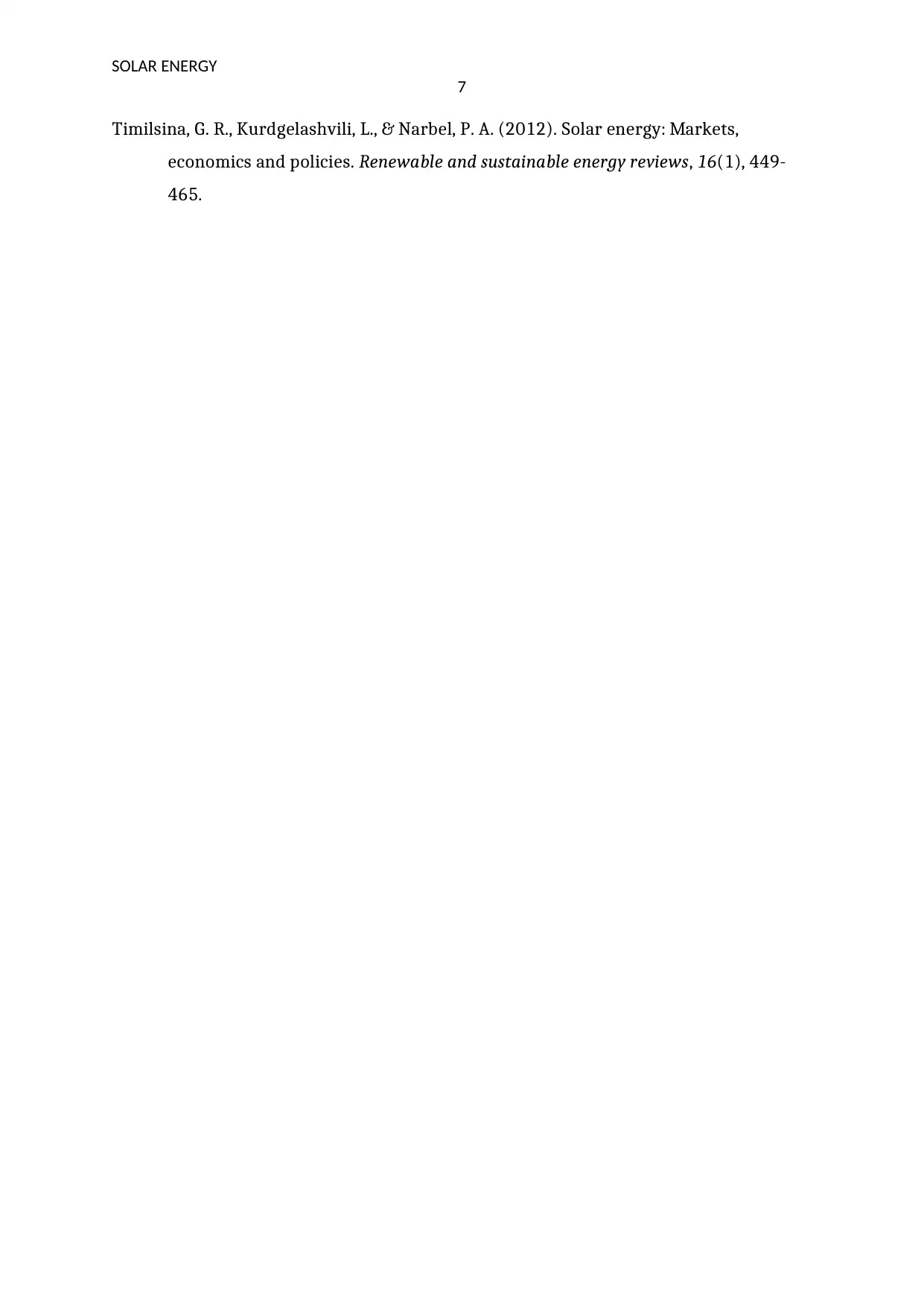
SOLAR ENERGY
7
Timilsina, G. R., Kurdgelashvili, L., & Narbel, P. A. (2012). Solar energy: Markets,
economics and policies. Renewable and sustainable energy reviews, 16(1), 449-
465.
7
Timilsina, G. R., Kurdgelashvili, L., & Narbel, P. A. (2012). Solar energy: Markets,
economics and policies. Renewable and sustainable energy reviews, 16(1), 449-
465.
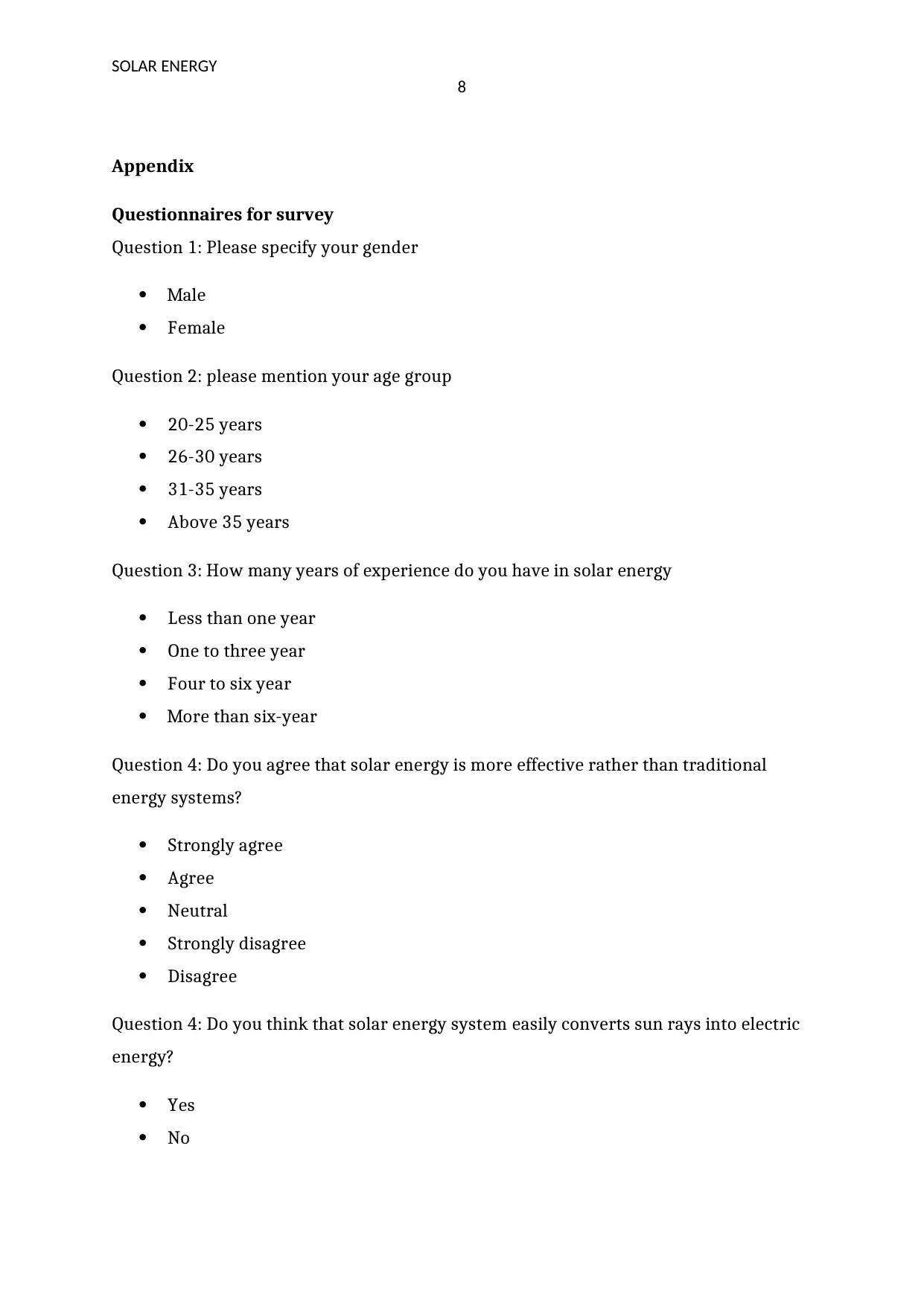
SOLAR ENERGY
8
Appendix
Questionnaires for survey
Question 1: Please specify your gender
Male
Female
Question 2: please mention your age group
20-25 years
26-30 years
31-35 years
Above 35 years
Question 3: How many years of experience do you have in solar energy
Less than one year
One to three year
Four to six year
More than six-year
Question 4: Do you agree that solar energy is more effective rather than traditional
energy systems?
Strongly agree
Agree
Neutral
Strongly disagree
Disagree
Question 4: Do you think that solar energy system easily converts sun rays into electric
energy?
Yes
No
8
Appendix
Questionnaires for survey
Question 1: Please specify your gender
Male
Female
Question 2: please mention your age group
20-25 years
26-30 years
31-35 years
Above 35 years
Question 3: How many years of experience do you have in solar energy
Less than one year
One to three year
Four to six year
More than six-year
Question 4: Do you agree that solar energy is more effective rather than traditional
energy systems?
Strongly agree
Agree
Neutral
Strongly disagree
Disagree
Question 4: Do you think that solar energy system easily converts sun rays into electric
energy?
Yes
No
⊘ This is a preview!⊘
Do you want full access?
Subscribe today to unlock all pages.

Trusted by 1+ million students worldwide
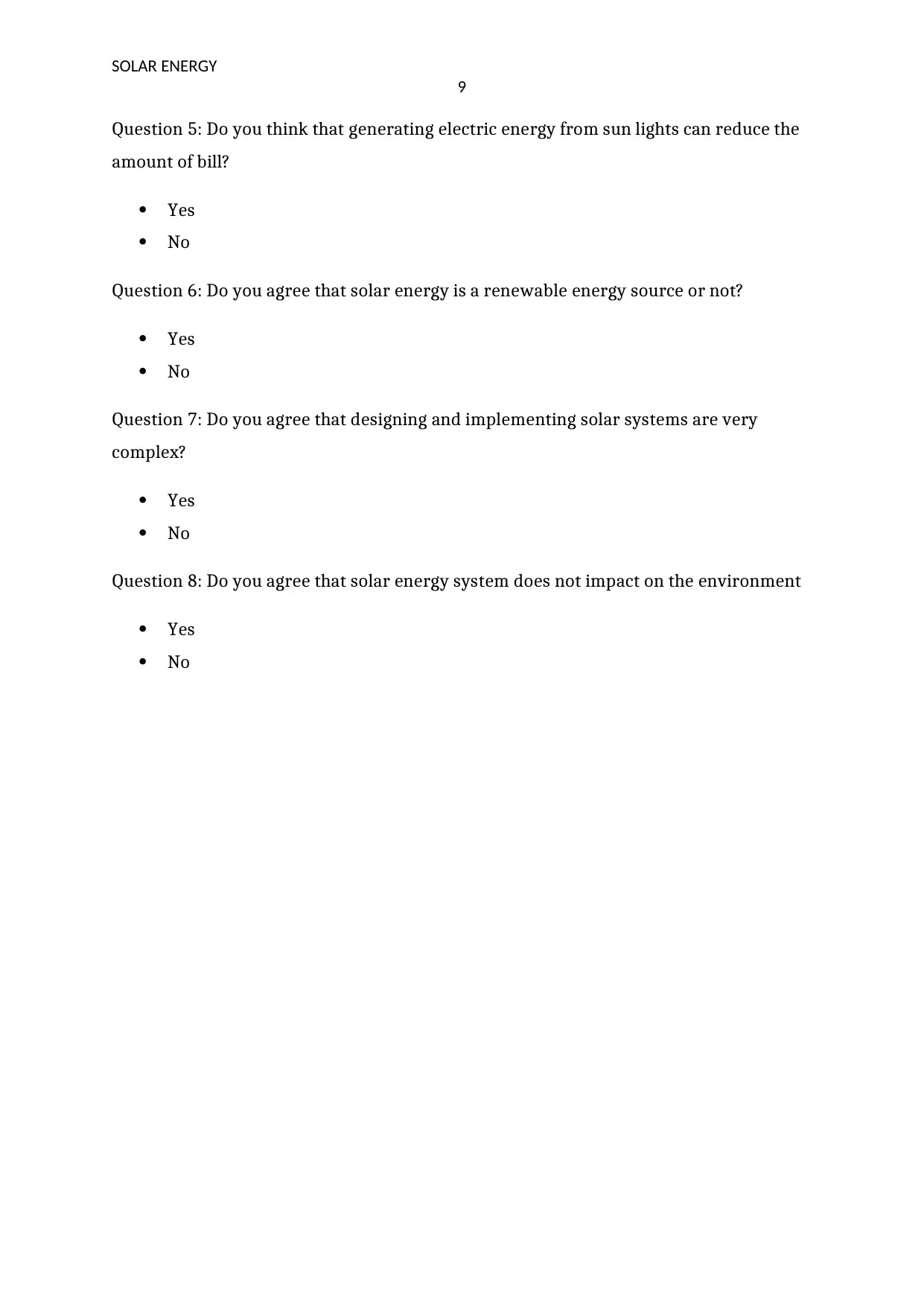
SOLAR ENERGY
9
Question 5: Do you think that generating electric energy from sun lights can reduce the
amount of bill?
Yes
No
Question 6: Do you agree that solar energy is a renewable energy source or not?
Yes
No
Question 7: Do you agree that designing and implementing solar systems are very
complex?
Yes
No
Question 8: Do you agree that solar energy system does not impact on the environment
Yes
No
9
Question 5: Do you think that generating electric energy from sun lights can reduce the
amount of bill?
Yes
No
Question 6: Do you agree that solar energy is a renewable energy source or not?
Yes
No
Question 7: Do you agree that designing and implementing solar systems are very
complex?
Yes
No
Question 8: Do you agree that solar energy system does not impact on the environment
Yes
No
Paraphrase This Document
Need a fresh take? Get an instant paraphrase of this document with our AI Paraphraser
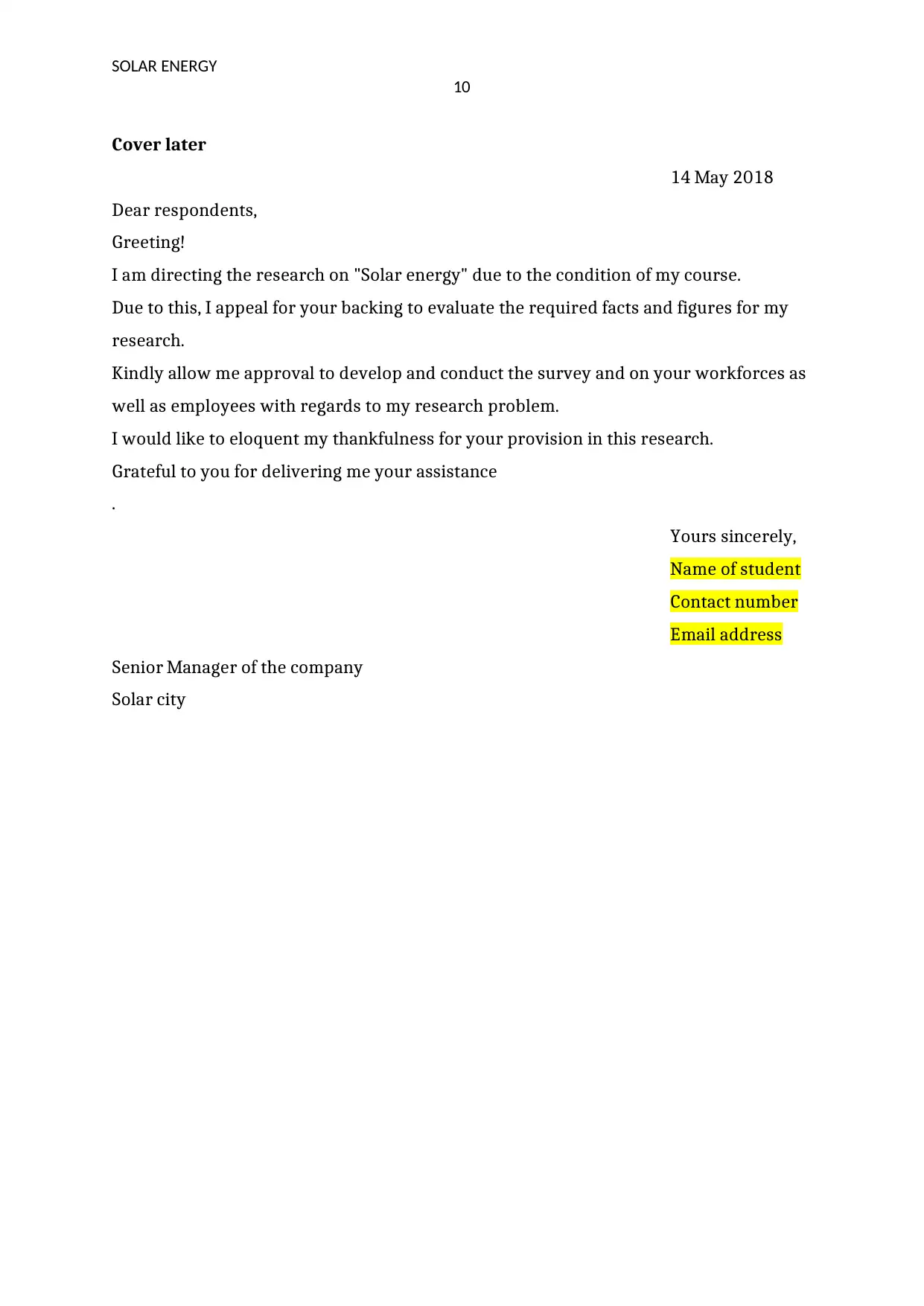
SOLAR ENERGY
10
Cover later
14 May 2018
Dear respondents,
Greeting!
I am directing the research on "Solar energy" due to the condition of my course.
Due to this, I appeal for your backing to evaluate the required facts and figures for my
research.
Kindly allow me approval to develop and conduct the survey and on your workforces as
well as employees with regards to my research problem.
I would like to eloquent my thankfulness for your provision in this research.
Grateful to you for delivering me your assistance
.
Yours sincerely,
Name of student
Contact number
Email address
Senior Manager of the company
Solar city
10
Cover later
14 May 2018
Dear respondents,
Greeting!
I am directing the research on "Solar energy" due to the condition of my course.
Due to this, I appeal for your backing to evaluate the required facts and figures for my
research.
Kindly allow me approval to develop and conduct the survey and on your workforces as
well as employees with regards to my research problem.
I would like to eloquent my thankfulness for your provision in this research.
Grateful to you for delivering me your assistance
.
Yours sincerely,
Name of student
Contact number
Email address
Senior Manager of the company
Solar city
1 out of 11
Related Documents
Your All-in-One AI-Powered Toolkit for Academic Success.
+13062052269
info@desklib.com
Available 24*7 on WhatsApp / Email
![[object Object]](/_next/static/media/star-bottom.7253800d.svg)
Unlock your academic potential
Copyright © 2020–2025 A2Z Services. All Rights Reserved. Developed and managed by ZUCOL.




